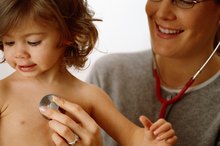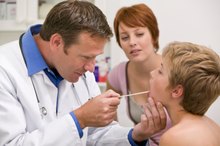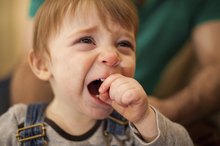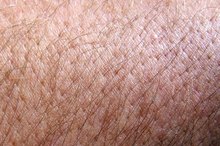When to Treat Molluscum Contagiosa and Warts in Children
Molluscum contagiosum is a skin infection caused by a virus that affects both adults and children. In children, the viral infection is transmitted through skin-to-skin contact and typically causes wart-like bumps or papules on the hands, neck, arms and face. If you suspect that your child has mollescum contagiosum, seek medical advice on treatment options from your health-care provider.
If you are experiencing serious medical symptoms, seek emergency treatment immediately.
Identification
Molluscum contagiosum causes skin lesions that could be easily confused with other types of skin conditions, says the University of Pittsburgh Medical Center 123. The skin lesions look like pearl-shaped, raised bumps on your child’s skin, typically on the face, armpits, hands, neck and other areas of the body except the palms of the hands or soles of the feet, notes the University of Maryland Medical Center 12. Also, unlike other similar-looking skin conditions like herpes or warts, molluscum contagiosum papules aren’t painful. The bumps are usually very small, only 0.2 inches in diameter, and are flesh-colored with a slight indentation in the center, explains the University of Michigan Health System 3.
Considerations
Jock Itch in Children
Learn More
Although molluscum contagiosum is considered a sexually transmitted disease in adults, it’s not viewed as an STD in children unless the infection occurs in the genital area, says the University of Michigan Health System 123. Your child can contract molluscum contagiosum from contact with an infected child’s skin or with contaminated toys, towels and other objects. The bumps can emerge from two weeks to six months after contracting molluscum contagiosum. Your child is at a much greater risk of contracting the virus if he has a suppressed immune system due to HIV/AIDS or a similar disease, warns the University of Pittsburgh Medical Center 12.
Treatments
Molluscum contagiosum typically resolves on its own in children with normal immune systems, says the University of Maryland Medical Center 123. If your child has an impaired immune system, she might require special treatment to cure the viral infection. In these cases, your child might need to have the skin lesions surgically removed or treated with chemicals like iodine, phenol, trichloracetic acid or cantharidin, notes the University of Pittsburgh Medical Center 12. Imiquimod and retinoid creams or cryotherapy using liquid nitrogen also are commonly utilized as treatments for molluscum contagiosum. Taking certain oral medications to eradicate the virus also might helpl, states the University of Michigan Health System 3.
Prevention
Molluscum Warts in Children
Learn More
Because molluscum contagiosum is most common among children, you should take certain preventive measures to protect your child, says the University of Michigan Health System 123. Ensure that your child doesn’t share towels at daycare and school or have skin-to-skin contact with infected children, advises the University of Maryland Medical Center 12. Molluscum contagiosum is highly contagious and can spread easily through contact with clothing and in baths or swimming pools, so encourage your child to avoid direct and indirect contact with infected peers, recommends the University of Pittsburgh Medical Center 123.
Warning
If your child has a suppressed immune system, he could experience persistent molluscum contagiosum infections that don’t clear up even after treatment, says the University of Maryland Medical Center 123. Or the skin lesions could clear up entirely after six to 18 months of treatment. Even if the lesions disappear, your child might have recurrences of molluscum contagiosum or develop a secondary bacterial infection in his skin. Encourage your child to avoid touching or scratching the skin bumps to prevent spreading molluscum contagiosum to others, warns the University of Pittsburgh Medical Center 123.
Related Articles
References
- University of Maryland Medical Center: Molluscum Contagiosum
- University of Pittsburgh Medical Center: Molluscum Contagiosum
- Silverberg NB. Pediatric Molluscum Contagiosum. Pediatric Drugs. 2003;5(8):505-512. doi:10.2165/00148581-200305080-00001
- Tyring SK. Molluscum contagiosum: the importance of early diagnosis and treatment. American Journal of Obstetrics and Gynecology. 2003;189(3). doi:10.1067/s0002-9378(03)00793-2
Resources
Writer Bio
Sarah Terry brings over 10 years of experience writing novels, business-to-business newsletters and a plethora of how-to articles. Terry has written articles and publications for a wide range of markets and subject matters, including Medicine & Health, Eli Financial, Dartnell Publications and Eli Journals.









